A Grand Tour of Britain’s Green A-List: 10 Native Plants to Know and Love
An in-depth guide to 10 of Britain’s native plants starting with A. Learn their secrets, from folklore and wildlife uses to gardening tips for your own patch.
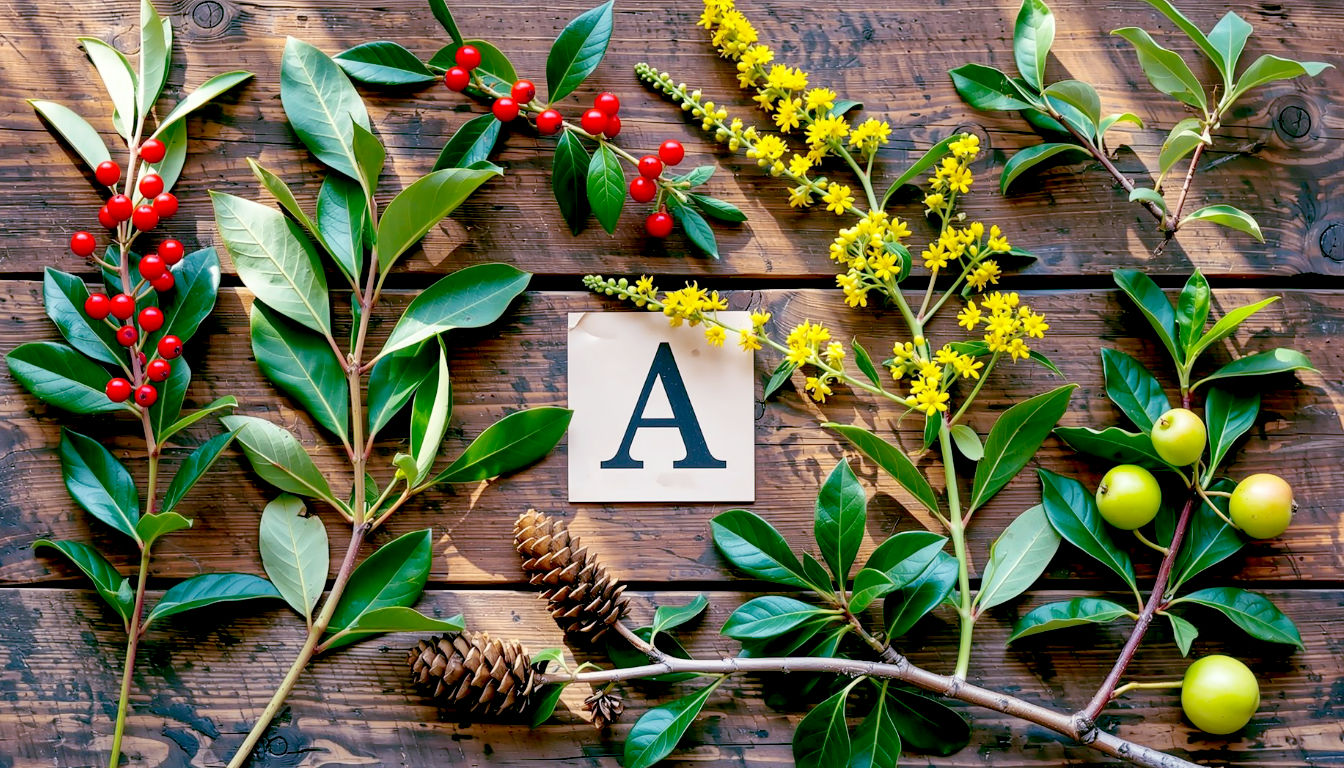
This post may contain affiliate links. If you make a purchase through these links, we may earn a commission at no additional cost to you.
Walk through any British woodland, wander along a riverbank, or peer into a tangled hedgerow, and you’re stepping into a living museum. Our native plants are the quiet, green heart of our island’s story. They’ve fed us, healed us, and fired our imaginations for thousands of years. But let’s be honest, telling one green leaf from another can feel a bit daunting.
So, where do you start? Why not at the very beginning? With ‘A’.
Think of this as your personal introduction to ten of Britain’s most fascinating native plants that all share the same first letter. We’re not just going to look at what they are; we’re going to uncover their secrets. We’ll learn how to spot them, where they love to grow, the wildlife that depends on them, and the strange and wonderful stories our ancestors told about them. From towering trees to humble herbs, this is your A-list guide to understanding the green world right on your doorstep.
1. Alder (Alnus glutinosa)
The Alder is the quiet guardian of our waterways. It’s a tree that doesn’t mind getting its feet wet, and its presence is a sure sign that water is nearby. It’s a pioneer, a soil-enricher, and a cornerstone of wetland ecosystems.
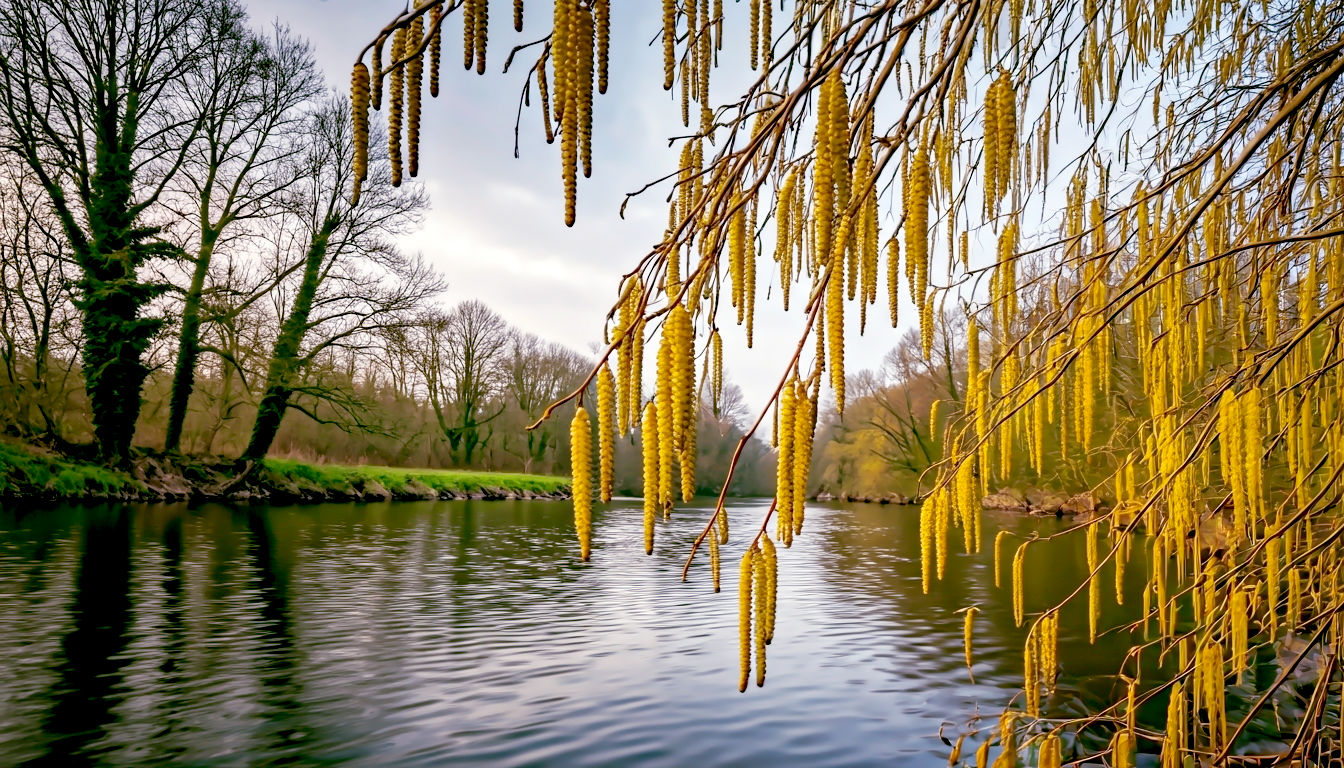
A Quick Look
- Type: Deciduous Tree
- Height: Up to 20 metres (about 65 feet)
- Habitat: Riverbanks, marshes, wet woodlands.
- Flowers: Long, dangling male catkins (lambs’ tails) and small, cone-like female flowers appear in early spring.
- Fun Fact: Alder wood is incredibly resistant to rot under water. It was used for the foundations of Venice!
What’s in a Name?
The name Alnus is the classical Latin name for the tree, while glutinosa means “sticky,” which refers to the feel of its young leaves and buds. In Celtic mythology, the Alder was associated with protection and prophecy. It was said that the head of the giant Bran the Blessed was hidden in an Alder tree, where it continued to speak and offer guidance.
How to Spot It
The Alder is a fairly easy tree to recognise, especially in winter.
- Bark: It has dark, fissured bark, often covered in lichen.
- Leaves: The leaves are rounded, almost circular, with a distinctive dent or notch at the tip, rather than a point. They have a glossy, dark green colour.
- Flowers & Cones: In late winter and early spring, look for the long, yellowish male catkins. The real giveaway, though, are the small, woody cones that stay on the tree all year round. No other native British deciduous tree has these.
Where It Calls Home
If there’s a river, stream, or bog, there’s a good chance an Alder is nearby. It thrives in damp, boggy ground where other trees would struggle. It’s found all across the UK, from the wetlands of Somerset to the lochs of Scotland.
A Friend to Wildlife
The Alder is a brilliant host. Its catkins provide an early source of nectar and pollen for bees, and many moth caterpillars, like the Alder Kitten and Pebble Hook-tip, munch on its leaves. In winter, birds like the Goldfinch and Siskin love to peck seeds from its tiny cones. Its roots also provide safe, sheltered nooks for fish and otters along riverbanks.
From Folklore to the Front Garden
Alder has a secret superpower: it can ‘fix’ nitrogen. It has special nodules on its roots that take nitrogen from the air and put it back into the soil, making it more fertile. Early farmers knew this and would often plant Alders to improve poor land.
The wood turns a deep orange-red when cut, which made people think it was bleeding. This, combined with its resistance to rot in water, gave it a magical reputation. It was used to make everything from clogs and cartwheels to the piles that hold up ancient crannogs (lake dwellings). While a bit big for most gardens, smaller varieties can be planted in damp areas to help stabilise soil and attract wildlife.
2. Agrimony (Agrimonia eupatoria)
Often overlooked in a grassy meadow, Agrimony is a delicate spire of yellow that has been a giant of the herbal medicine cabinet for centuries. It’s a plant with a gentle appearance but a powerful history.
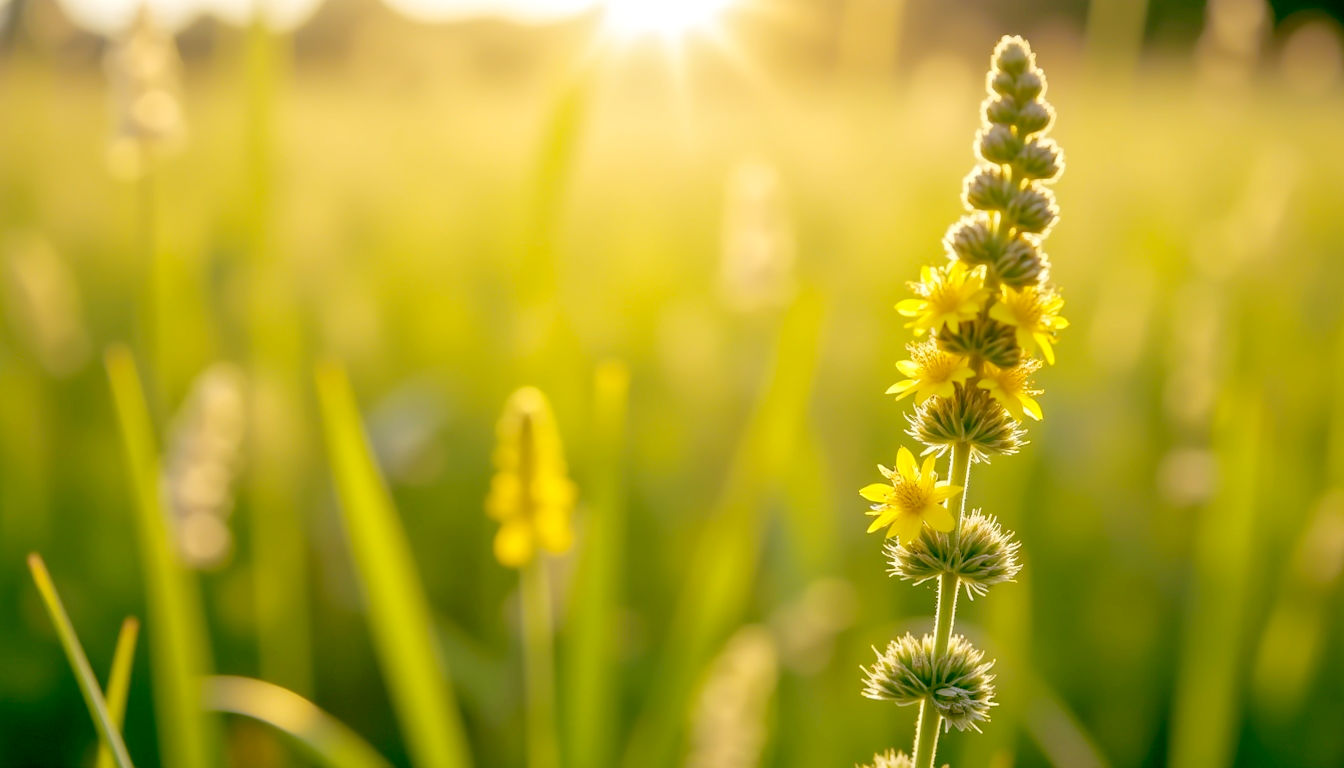
A Quick Look
- Type: Perennial Herb
- Height: 30-60 cm (1-2 feet)
- Habitat: Meadows, roadside verges, woodland edges, scrubland.
- Flowers: Small, star-shaped yellow flowers arranged on a tall, slender spike. Blooms from June to September.
- Fun Fact: The flowers have a faint, apricot-like scent.
What’s in a Name?
The name Agrimonia is thought to come from the Greek argemon, meaning “cataract,” as it was once believed to cure eye ailments. Its other common name, “church steeples,” beautifully describes the tall, elegant flower spike. It was also known as “sticklewort” or “cocklebur” because of its seed pods.
How to Spot It
Look for a tall, hairy stem rising from a cluster of leaves at the base.
- Leaves: The leaves are deeply divided and toothed, a bit like a strawberry leaf. They are green on top and a downy, silvery-white underneath.
- Flowers: The main feature is the spire of small, five-petalled yellow flowers. As the summer goes on, the flowers at the bottom of the spike turn to seed while new ones open at the top.
- Seeds: After flowering, it produces distinctive burred seed pods that catch on the fur of animals (or your trousers) to get around.
Where It Calls Home
Agrimony loves sunny, grassy places with well-drained, lime-rich soil. It’s a common sight in traditional hay meadows, on chalk downlands, and along countryside footpaths throughout most of Britain.
A Friend to Wildlife
Its flowers are a valuable source of nectar for bees, hoverflies, and butterflies. The Grizzled Skipper butterfly caterpillar, in particular, feeds on its leaves.
From Folklore to the Front Garden
Agrimony was a superstar of the herbal world. It was a classic “wound-wort,” used to staunch bleeding and heal sores. It was also brewed into a tea to treat everything from sore throats and fevers to liver complaints. In folklore, it was said that a sprig of Agrimony placed under a person’s pillow would make them sleep soundly until it was removed.
For gardeners, it’s a wonderful, low-maintenance plant for a wildflower meadow or a sunny border. It’s easy to grow from seed and will happily self-seed once established, bringing a touch of ancient meadowland to your patch.
3. Alexanders (Smyrnium olusatrum)
Step back in time with Alexanders, a plant that’s a living relic of the Roman occupation of Britain. It’s a tall, striking plant with glossy leaves and a powerful, celery-like scent, especially common near the coast.

A Quick Look
- Type: Biennial Herb (lives for two years)
- Height: Up to 1.5 metres (5 feet)
- Habitat: Coastal paths, cliffs, hedgerows, and waste ground, especially in the south.
- Flowers: Umbels (umbrella-like clusters) of tiny yellow-green flowers from April to June.
- Fun Fact: Before celery was cultivated, Alexanders was the go-to vegetable for adding a savoury, aromatic flavour to dishes.
What’s in a Name?
Smyrnium comes from the Greek word for myrrh, referring to its aromatic smell. Olusatrum means “black pot-herb,” likely referring to its black seeds. The common name “Alexanders” is thought to honour Alexander the Great, as the plant originates from the Mediterranean, which he conquered.
How to Spot It
Alexanders is one of the first tall green plants to appear in spring.
- Stems: The stems are solid but become hollow with age, and are often grooved.
- Leaves: They are very large, glossy, and bright green, divided into toothed leaflets, a bit like a giant, shiny parsley. If you crush a leaf, it releases a strong, unique, aromatic scent.
- Flowers: The flowers are tiny and yellowish, held in large, rounded umbels. This shape is typical of the carrot family, which also includes Cow Parsley and Hogweed.
- Seeds: The flowers are followed by ribbed, black seeds.
Where It Calls Home
This plant is a true coastal lover. You’ll find it in dense thickets along cliff tops, footpaths, and in hedgerows all around the coast of southern Britain. It’s less common further north but is spreading inland along roads and railway lines.
A Friend to Wildlife
Its early flowers are a lifeline for insects emerging from hibernation, providing a crucial source of nectar for bees, hoverflies, and beetles when not much else is in bloom.
From Folklore to the Front Garden
The Romans brought Alexanders to Britain to use as a food and medicinal herb. Every part of the plant was eaten: the leaves and stems were used like spinach or celery, the flower buds were added to salads, and the roots were cooked like parsnips. It fell out of favour in the Middle Ages when celery became more popular.
A Word of Warning: While edible, Alexanders can look similar to some very poisonous plants in the same family, like Hemlock Water-dropwort. Never eat a wild plant unless you are 100% certain of its identity.
4. Angelica (Angelica sylvestris)
Wild Angelica is a statuesque giant of damp meadows and woodlands. With its huge, exploding firework-like flower heads and sturdy purple stems, it brings a touch of architectural drama to the late summer landscape.
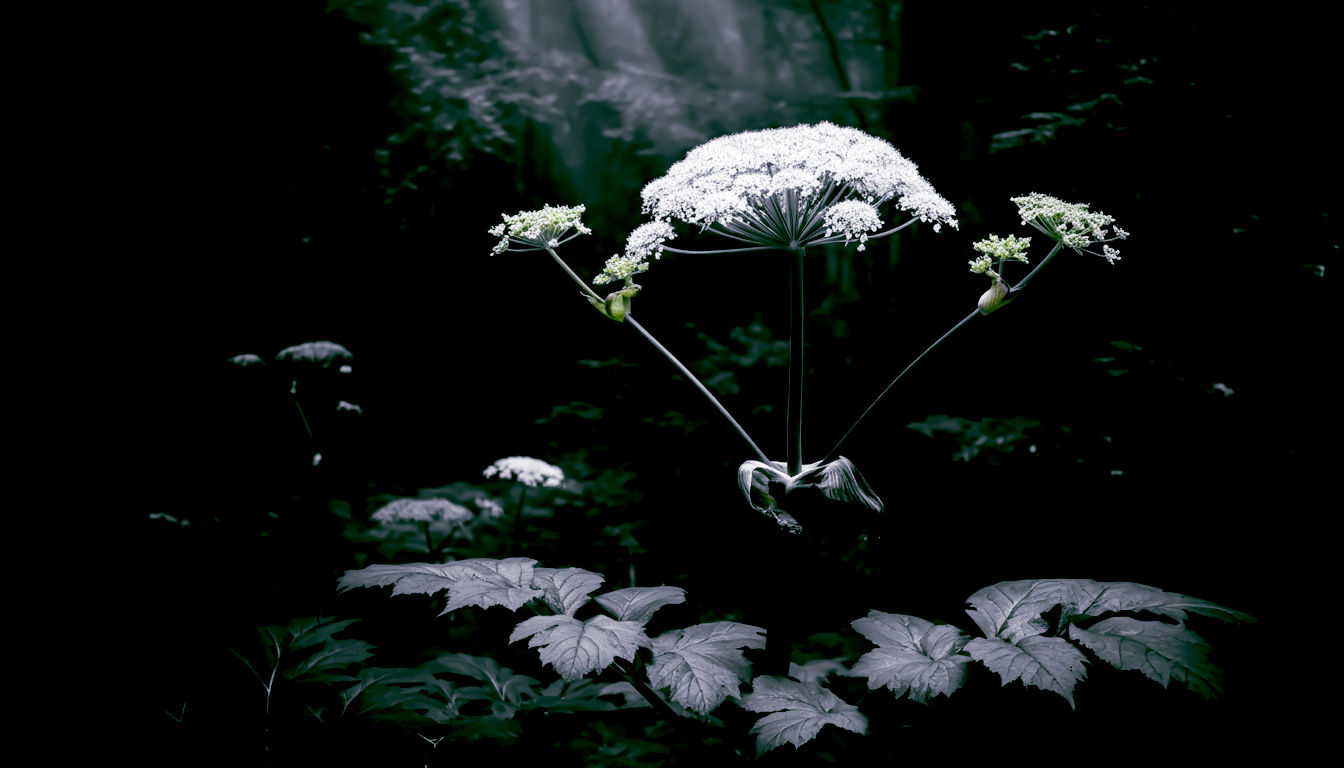
A Quick Look
- Type: Biennial or short-lived Perennial Herb
- Height: Can reach over 2 metres (6.5 feet)
- Habitat: Damp woodlands, marshes, riverbanks, fens.
- Flowers: Large, dome-shaped umbels of tiny white or pinkish flowers, blooming from July to September.
- Fun Fact: Its candied stems were a popular sweet treat from Tudor times right up until the 20th century.
What’s in a Name?
Angelica comes from the Latin angelus, meaning “angel.” According to legend, the Archangel Michael appeared to a monk in a dream and revealed the plant as a cure for the plague. Sylvestris simply means “of the woods.” Its heavenly name reflects its reputation as a powerful, protective herb.
How to Spot It
Look for a tall, robust plant in a damp spot.
- Stems: The stems are thick, hollow, and often have a purplish tinge. They are ridged and slightly hairy.
- Leaves: The leaves are huge, especially at the base of the plant, and are divided into many smaller leaflets. A key feature is the inflated, sheath-like base where the leaf stalk joins the main stem.
- Flowers: The flower heads are the star of the show – massive, rounded umbels made up of hundreds of tiny white or pink-flushed flowers. They can be as big as a dinner plate.
Where It Calls Home
Like the Alder tree, Angelica loves damp ground. It’s a common sight in wet meadows, fens, and along the banks of ditches and streams throughout the UK.
A Friend to Wildlife
The open structure of its flower heads makes them a perfect landing pad for a huge variety of insects. Hoverflies, bees, wasps, and beetles flock to its nectar. The hollow stems also provide important overwintering sites for insects like queen wasps.
From Folklore to the Front Garden
Angelica was considered one of the most potent magical herbs. It was carried for protection against evil spirits and witchcraft and was grown in monastery gardens as a cure-all. In Scandinavian countries, its roots were used to flavour alcoholic drinks like gin and vermouth.
In the garden, it’s a stunning architectural plant for a damp border or a bog garden. It will attract a buzz of insect life and add height and drama, especially in late summer.
5. Ash (Fraxinus excelsior)
The Ash is one of our most common and beloved trees. Tall, graceful, and elegant, its pale grey bark and delicate leaves have shaped our landscapes and culture for millennia. But today, this noble giant is facing a terrible threat.
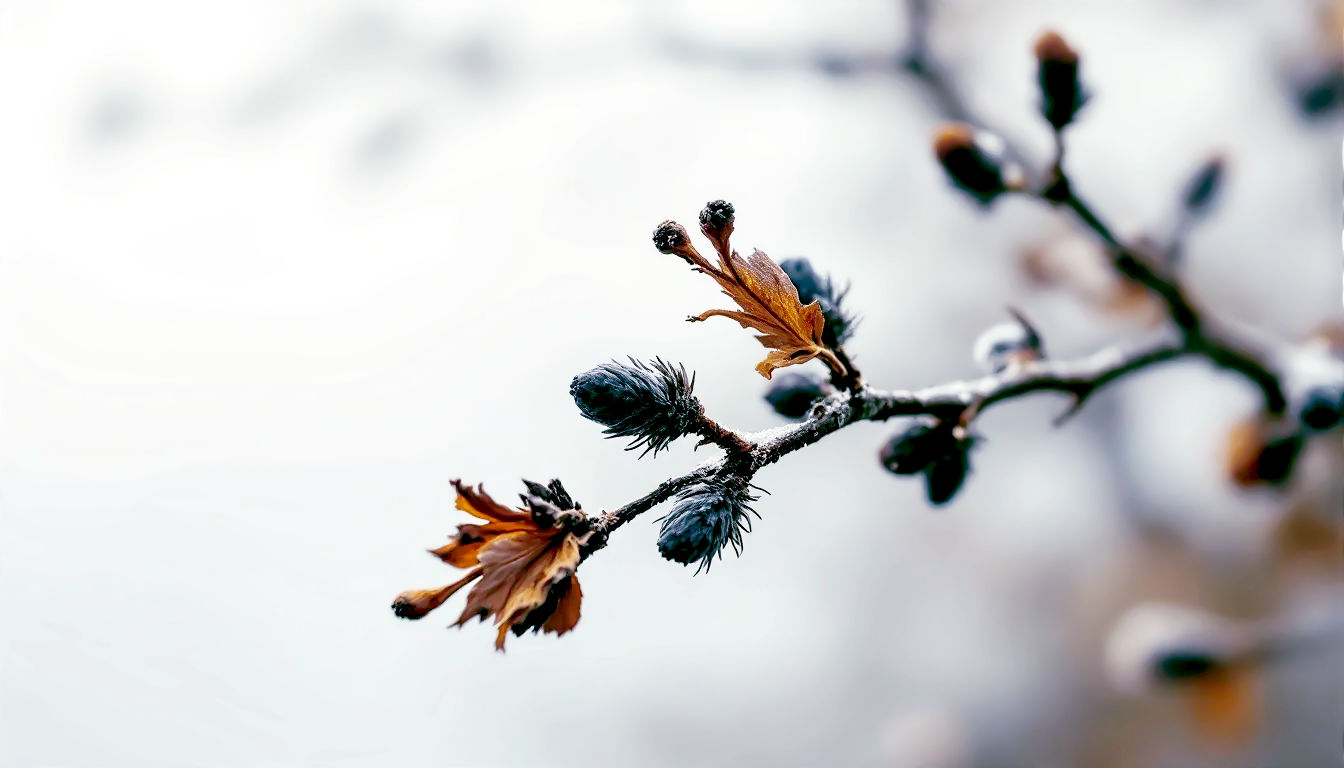
A Quick Look
- Type: Deciduous Tree
- Height: Up to 35 metres (115 feet), sometimes taller.
- Habitat: Woods, hedgerows, parks, often on lime-rich soils.
- Flowers: Inconspicuous, purplish flowers appear in spring before the leaves.
- Fun Fact: Ash wood is incredibly strong and flexible, making it the traditional choice for tool handles, oars, and snooker cues.
What’s in a Name?
Fraxinus is the classical Latin name for the Ash tree, while excelsior means “taller” or “higher,” a fitting description for this lofty tree. The English word “Ash” comes from the Old English æsc.
How to Spot It
The Ash has several distinctive features that make it easy to identify, especially in winter.
- Buds: The most obvious clue is its sooty-black, velvety buds. They sit in opposite pairs along the twigs, with a larger terminal bud at the tip.
- Bark: The bark is pale grey and smooth on young trees, developing a network of diamond-shaped fissures as it ages.
- Leaves: The leaves are “pinnate,” meaning they are made up of 3-6 pairs of slender, toothed leaflets arranged opposite each other, with one extra leaflet at the tip.
- Seeds: In autumn, look for the bunches of winged seeds, famously known as “Ash keys,” which hang on the tree long into winter.
Where It Calls Home
Ash is one of the most common trees in the UK, found almost everywhere except for the acid soils of heathlands and some parts of the Scottish Highlands. It’s a key tree in ancient woodlands and a familiar sight in our hedgerows.
A Friend to Wildlife
An Ash tree is a city of wildlife. Over 100 species of insect rely on it. Its open canopy lets light reach the woodland floor, allowing wildflowers like bluebells and dog violets to thrive. Bullfinches eat the seeds, and woodpeckers and owls nest in its trunk.
From Folklore to the Front Garden
In Norse mythology, the entire cosmos was held within the branches of a giant Ash tree called Yggdrasil. The Ash was seen as a tree of healing and protection. People believed that passing a sick child through a split Ash sapling could cure them.
A Word of Warning: Ash Dieback
Sadly, we can’t talk about the Ash without mentioning the devastating disease called Ash Dieback. Caused by a fungus, it has spread across Europe and is now widespread in the UK. It causes the leaves to wilt and the crown of the tree to die back, eventually killing it. It is predicted to wipe out the vast majority of our Ash trees, changing our landscape forever. We can only hope that the small percentage of trees that show resistance will be able to produce a new, healthy generation of Ash for the future.
6. Aspen (Populus tremula)
The Aspen is the dancer of the British woodland. Even on the calmest day, its leaves seem to be in constant motion, shimmering and rustling with a sound like gentle rain. It’s a slender, beautiful tree that brings light and life wherever it grows.

A Quick Look
- Type: Deciduous Tree
- Height: Up to 20 metres (65 feet)
- Habitat: Open woodland, heathland, parkland, often on damp, acidic soils.
- Flowers: Long, woolly catkins appear in early spring.
- Fun Fact: Aspens rarely grow from seed in the UK. Instead, they spread by sending up new shoots, or suckers, from their roots, forming large colonies of genetically identical clones.
What’s in a Name?
Populus is the Latin name for the poplar family, of which the Aspen is a member. The species name tremula means “to tremble,” which is the perfect description for its quivering leaves. This is also where its other common name, Quaking Aspen, comes from.
How to Spot It
The trembling leaves are the biggest clue.
- Leaves: The leaves are small and almost perfectly round, with rounded teeth along the edges. The reason they tremble is that their leaf stalks are flattened and very flexible, acting like hinges that allow the leaf to twist and flutter in the slightest breeze.
- Bark: The bark is a smooth, greyish-green, often with diamond-shaped marks called lenticels. It becomes darker and more rugged at the base of older trees.
- Shape: It’s a slender, elegant tree, often growing in groups or thickets. In autumn, the leaves turn a brilliant, clear yellow or sometimes even red.
Where It Calls Home
Aspen is found throughout the UK but is most common in the north of England and Scotland, particularly in the ancient Caledonian forests of the Highlands. It can pop up in all sorts of open, sunny places.
A Friend to Wildlife
Aspen is fantastic for wildlife. It’s the food plant for the caterpillars of several rare moths, and its bark is a favourite of beavers (where they have been reintroduced). The soft wood is easily excavated by woodpeckers for nesting holes, which are then used by other birds like the Redstart.
From Folklore to the Front Garden
The constantly moving leaves of the Aspen gave it a reputation for being restless and magical. In Christian folklore, it was said that the cross on which Christ was crucified was made of Aspen wood, and the tree has trembled with shame ever since. In the Scottish Highlands, it was known as the “shivering tree” and was thought to have healing properties.
Because it suckers so readily, a single Aspen can quickly become a small grove, making it a great choice for rewilding projects or for gardeners wanting to create a small patch of native woodland.
7. Avens, Wood (Geum urbanum)
Tucked away in the shady corners of woodlands and hedgerows, Wood Avens is a humble but charming little plant. Its cheerful yellow flowers might catch your eye, but its roots hold an ancient, spicy secret.

A Quick Look
- Type: Perennial Herb
- Height: 20-60 cm (8-24 inches)
- Habitat: Shady places like woodlands, hedgerows, gardens, and path edges.
- Flowers: Small, five-petalled yellow flowers, similar to a buttercup but with more pointed petals. Blooms from May to August.
- Fun Fact: The root, when crushed, smells faintly of cloves.
What’s in a Name?
Geum is a name used by the Roman writer Pliny for a plant with an aromatic root. Urbanum means “of the city,” suggesting it was commonly found growing on walls and in town gardens even in ancient times. Its common name, Herb Bennet, comes from the Latin Herba Benedicta, the “blessed herb,” due to its power to ward off evil.
How to Spot It
Wood Avens is a wiry, hairy plant.
- Leaves: It has a rosette of large leaves at the base, which are divided into several lobes. The leaves on the stem are smaller and simpler.
- Flowers: The flowers are small (about 1-2 cm across), bright yellow, and star-shaped. They nod downwards slightly on their thin stalks.
- Seeds: After flowering, it produces a burr-like seed head. Each seed has a tiny hook on the end, perfect for latching onto passing animals or people.
Where It Calls Home
This is not a fussy plant. It’s happy in most shady spots and can be found in almost any woodland, hedgerow, or neglected garden corner across the whole of the UK. It’s one of our most common woodland flowers.
A Friend to Wildlife
Its simple, open flowers are easily accessible to a wide range of pollinators, including hoverflies and bees.
From Folklore to the Front Garden
Thanks to its clove-scented root, Wood Avens was a powerful plant in medieval times. It was known as the blessed herb because it was believed to drive away the devil and protect against venomous beasts and witches. The root was carried as an amulet and hung in houses to keep them safe.
It was also used as a spice. The root was dried and powdered to flavour ale (giving it a clove-like taste and preventing it from going sour) and was used in stews and broths as a cheap substitute for expensive imported cloves. It also had various uses in herbal medicine as a mild antiseptic and to treat digestive problems.
8. Apple, Crab (Malus sylvestris)
The Crab Apple is our only truly native apple tree. It’s the wild, gnarled ancestor of the thousands of apple varieties we eat today. It’s a tree of twisted branches, beautiful spring blossoms, and intensely sour little fruits that pack a surprising punch.
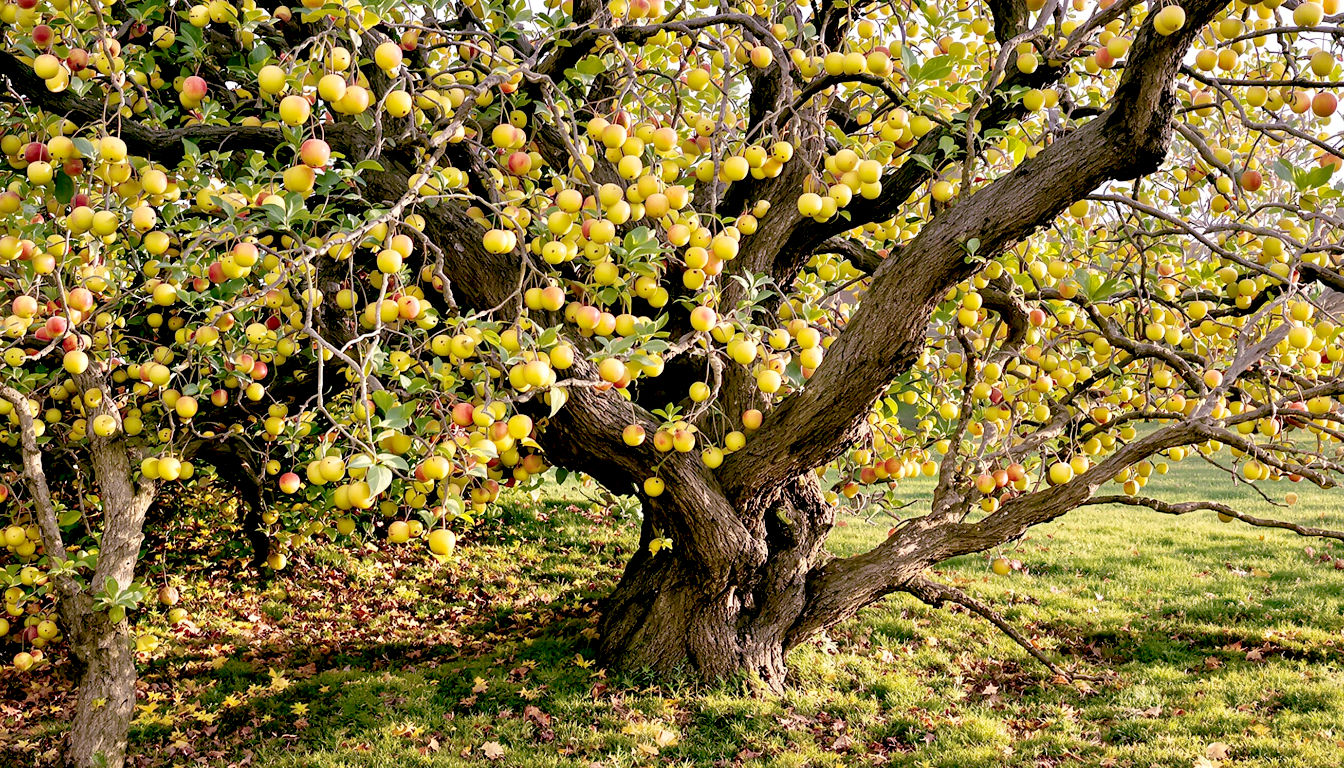
A Quick Look
- Type: Deciduous Tree
- Height: Up to 10 metres (33 feet)
- Habitat: Ancient woodlands, old hedgerows, scrubland.
- Flowers: Beautiful pink-tinged white blossom in May.
- Fun Fact: The word “crab” in its name comes from a Norse word, skrab, meaning “scrubby” or “stunted,” referring to its wild, tangled appearance.
What’s in a Name?
Malus is the Latin name for apple, and sylvestris means “of the woods,” perfectly describing this wild tree. It’s often called the “wild crab” to distinguish it from cultivated apples that have gone wild.
How to Spot It
A true wild Crab Apple is a small, often thorny, and gnarly-looking tree.
- Shape: It has an irregular, spreading crown with tangled, sometimes spiny branches.
- Bark: The bark is greyish-brown and becomes fissured and rough with age.
- Blossom: In spring, it’s covered in glorious five-petalled blossom, which is white flushed with delicate pink. The scent is sweet and heady.
- Fruit: The apples themselves are the biggest clue. They are very small (only 2-3 cm across), hard, and yellowish-green, sometimes with a red blush. And if you try to eat one raw, your face will tell you all you need to know – they are incredibly sour!
Where It Calls Home
The Crab Apple is a key component of ancient woodlands and traditional hedgerows throughout England, Wales, and southern Scotland. It’s a sign that a wood or hedge is old and has been undisturbed for a long time.
A Friend to Wildlife
The blossom provides a fantastic source of early nectar and pollen for bees and other insects, which are vital for pollinating the flowers. The caterpillars of many moths feed on its leaves. In autumn, the fallen fruit is a valuable food source for birds like blackbirds and thrushes, and mammals like badgers, foxes, and mice.
From Folklore to the Front Garden
The Crab Apple is steeped in folklore and is often seen as a tree of love and marriage. It was a sacred tree to the Celts. Its sour fruit was never eaten raw but was a vital ingredient for our ancestors. It’s incredibly high in pectin, the substance that makes jam set. A few Crab Apples thrown in with other fruits would guarantee a good set for any preserve. They were also used to make a tart, amber-coloured jelly and a potent, alcoholic drink called verjuice.
The tradition of wassailing, where people would sing to apple trees in orchards to ensure a good harvest, would have originally been directed at these wild Crab Apples. For gardeners, they make a beautiful small tree, offering stunning blossom, autumn colour, and fruit for the birds (and for jelly-makers!).
9. Arum, Wild (Arum maculatum)
This is one of the most exotic and intriguing plants in the British flora. With its glossy, arrow-shaped leaves, strange hooded flower, and spike of poisonous scarlet berries, it has more mystery about it than almost any other native plant.
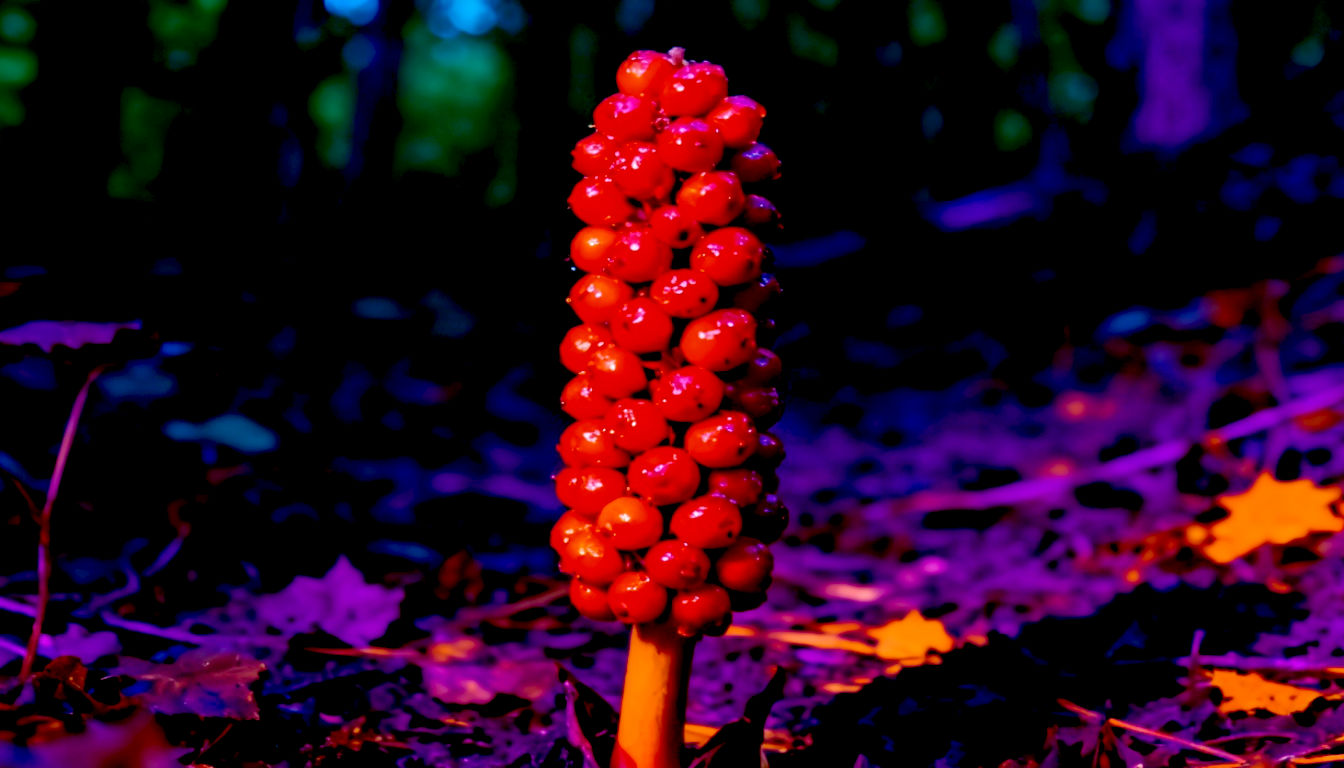
A Quick Look**
- Type: Perennial Herb
- Height: 15-40 cm (6-16 inches)
- Habitat: Damp, shady woodlands and hedgerows.
- Flowers: A strange, poker-like spike (the spadix) inside a pale green, hood-like sheath (the spathe), appearing in April and May.
- Fun Fact: The flower emits a faint, foul smell and generates its own heat to attract pollinating insects.
What’s in a Name?
Arum is the classical Greek name for this plant. Maculatum means “spotted,” as the leaves sometimes have purple-black spots. It has a huge number of folk names, more than almost any other plant. Lords-and-Ladies and Cuckoopint are the most common. Others include Devils and Angels, Wake Robin (as it appears when the robins start singing in spring), and Adam and Eve. Many of these names refer to the appearance of the male and female parts of the flower within the hood.
How to Spot It
In early spring, look for its distinctive leaves unfurling on the woodland floor.
- Leaves: They are large, glossy, and shaped like arrowheads.
- Flower: The flower is unmistakable. A pale green, cowl-like spathe wraps around a purplish-brown central poker, the spadix.
- Berries: In late summer, after the leaves and hood have withered away, a single, bare stalk remains, bearing a cluster of tightly packed, brilliant scarlet berries. They look incredibly tempting but are extremely poisonous.
Where It Calls Home
Wild Arum loves the deep shade and damp, rich soil of ancient woodlands and old hedgerows. It’s common throughout England and Wales, becoming rarer in Scotland.
A Friend to Wildlife
The plant has a fascinating and devious relationship with wildlife. The foul smell and heat produced by the spadix attract tiny midges, particularly a species called the Owl Midge. They slide down the slippery inside of the spathe and are trapped by a ring of hairs. They are held prisoner overnight, during which time they pollinate the female flowers at the base of the spadix. The next day, the hairs wither, and the midge is released, covered in pollen from the male flowers which have now ripened, ready to be tricked by the next Arum flower it visits.
From Folklore to the Front Garden
The plant’s strange appearance gave it a powerful reputation. The root tuber is rich in starch and, after being carefully roasted and ground to destroy the poison, was used to make a type of starch called Portland Sago, used to stiffen the elaborate ruffs of Elizabethan collars.
A Word of Warning: All parts of the Wild Arum are poisonous. The sap can irritate the skin, and eating the berries can cause severe swelling of the mouth and throat and can be fatal, especially for children. It should be admired from a distance and never, ever eaten.
10. Adder’s-tongue Fern (Ophioglossum vulgatum)
Our final ‘A’ is a strange and secretive little plant. The Adder’s-tongue is a fern, but it doesn’t look like one. It doesn’t have the familiar feathery fronds. Instead, it produces a single, smooth leaf and a curious little spike that gives it its name.

A Quick Look
- Type: Fern
- Height: 10-20 cm (4-8 inches)
- Habitat: Unimproved, damp meadows, old lawns, churchyards.
- Reproduction: A fertile spike, not a flower, releases spores in June and July.
- Fun Fact: This tiny fern holds a Guinness World Record for having the most chromosomes of any known living thing – over 1,260! (Humans have just 46).
What’s in a Name?
Ophioglossum comes from the Greek for “snake’s tongue,” which is a perfect description of the spore-bearing spike. Vulgatum means “common,” although it can be very difficult to find!
How to Spot It
Finding Adder’s-tongue requires patience and sharp eyes. It’s small and easily hidden amongst grass.
- Leaf: Each plant produces just a single, fleshy, oval leaf that is smooth and lacks a central midrib. It looks more like a leaf from a flowering plant than a fern.
- Spike: From the base of this leaf, a single, unbranched stalk emerges, topped with a narrow, pointed structure that looks like a tiny tongue or spear tip. This spike contains the spores.
Where It Calls Home
Adder’s-tongue is a plant of old, undisturbed grasslands. It grows in ancient hay meadows, on village greens, and in country churchyards – places that haven’t been ploughed or treated with chemical fertilisers. These habitats are becoming increasingly rare, and so is this little fern. It’s found scattered across the UK.
From Folklore to the Front Garden
Because of its snake-like appearance, Adder’s-tongue was used in traditional medicine to treat snakebites, based on the “Doctrine of Signatures” – the belief that a plant’s appearance indicated what it could cure. An ointment made from the leaves was also a very popular remedy for healing wounds.
It’s not really a garden plant, as it needs the very specific soil conditions of an ancient meadow to thrive. Finding it in the wild is a special treat and a sign that you are standing in a truly ancient piece of countryside.
Conclusion: Reading the Green Pages of Britain’s Story
Our journey through the ‘A’ list is complete. We’ve walked with the water-loving Alder, stood under the mighty Ash, and marvelled at the shimmering leaves of the Aspen. We’ve peered into the strange, hooded flower of the Wild Arum and sought out the delicate yellow spires of Agrimony in sunny meadows. From the Roman history of Alexanders to the ancient magic of Wood Avens and the wild tang of the Crab Apple, we’ve only scratched the surface.
But what have we really discovered? More than just a list of ten plants, this has been an introduction to a new language—the language of the British landscape.
We’ve learned that our hedgerows and woodlands are not just a green backdrop; they are living libraries, and every plant is a book filled with stories. They tell tales of history, showing us where ancient people lived and what they ate. They are manuals of survival, revealing which creatures depend on them for food and shelter. And they are collections of folklore, whispering the beliefs and remedies of our ancestors.
Perhaps the most important lesson is that no plant stands alone. Each is a vital thread in an intricate web of life. The Ash tree isn’t just wood; it’s a home for birds and a feast for insects. The Angelica’s flower isn’t just for show; it’s a landing pad for countless pollinators. Understanding these connections is the first step to understanding the health of our countryside.
This journey through the letter ‘A’ was simply the first page. The real adventure begins now. It starts the next time you step outside and, instead of just seeing ‘weeds’ or ‘trees’, you recognise a familiar face. You might spot the glossy, arrow-shaped leaf of a Lords-and-Ladies and remember its secret trap for flies. You might see a flash of yellow and identify the ‘church steeples’ of Agrimony.
You don’t need to be an expert. You just need to be curious. The rest of the alphabet is out there, waiting for you in the fields, forests, and fens. So go on, turn the page.
Further Reading and Resources
To continue your botanical journey, these organisations are invaluable resources:
- The Woodland Trust: The UK’s largest woodland conservation charity. An incredible source of information on native trees and woods.
- Plantlife: A British conservation charity working to save threatened wild flowers, plants, and fungi.
- The Royal Horticultural Society (RHS): The UK’s leading gardening charity, with extensive advice on native plants for your garden.
- The Wildlife Trusts: A grassroots movement of people saving wildlife and wild places. Great for finding local nature reserves to explore.






